NCBI Bookshelf. A service of the National Library of Medicine, National Institutes of Health.
National Guideline Alliance (UK). Cerebral palsy in under 25s: assessment and management. London: National Institute for Health and Care Excellence (NICE); 2017 Jan. (NICE Guideline, No. 62.)
F.2. Causes of cerebral palsy
F.3. Clinical and developmental manifestations of cerebral palsy
F.4. Red flags for other neurological disorders
F.5. MRI and identification of causes of cerebral palsy
F.6. MRI and prognosis of cerebral palsy
F.7. Prognosis for walking, talking and life expectancy
F.8. Information and support
F.9. Assessment of eating, drinking and swallowing difficulties
F.10. Management of eating, drinking and swallowing difficulties
F.11. Optimising nutritional status
F.12. Improving speech, language and communication: Speech intelligibility
F.13. Improving speech, language and communication: Communication systems
F.14. Managing saliva control
F.15. Risk factors for low bone mineral density
F.16. Prevention of reduced bone mineral density
F.17. Assessment of pain, distress and discomfort and sleep disturbance
F.18. Causes of pain, discomfort, disress, and sleep disturbance
F.19. Management of pain, distress and discomfort
F.20. Management of sleep disturbances
F.21. Assessment of mental health problems
F.22. Management of mental health problems
F.23. Management of sensory and perceptual difficulties
F.24. Other comorbidities in cerebral palsy
F.25. Social care needs
F.26. Transition to adult services
- Risk factors
- Causes of cerebral palsy
- Clinical and developmental manifestations of cerebral palsy
- Red flags for other neurological disorders
- MRI and identification of causes of cerebral palsy
- MRI and prognosis of cerebral palsy
- Prognosis for walking, talking and life expectancy
- Information and support
- Assessment of eating, drinking and swallowing difficulties
- Management of eating, drinking and swallowing difficulties
- Optimising nutritional status
- Improving speech, language and communication: Speech intelligibility
- Improving speech, language and communication: Communication systems
- Managing saliva control
- Risk factors for low bone mineral density
- Prevention of reduced bone mineral density
- Assessment of pain, distress and discomfort and sleep disturbance
- Causes of pain, discomfort, disress, and sleep disturbance
- Management of pain, distress and discomfort
- Management of sleep disturbances
- Assessment of mental health problems
- Management of mental health problems
- Management of sensory and perceptual difficulties
- Other comorbidities in cerebral palsy
- Social care needs
- Transition to adult services
- Health economics
- Summary of Identified Studies - Cerebral palsy in under 25s: assessment and mana...Summary of Identified Studies - Cerebral palsy in under 25s: assessment and management
- MRI and prognosis of cerebral palsy - Cerebral palsy in under 25s: assessment an...MRI and prognosis of cerebral palsy - Cerebral palsy in under 25s: assessment and management
Your browsing activity is empty.
Activity recording is turned off.
See more...



























